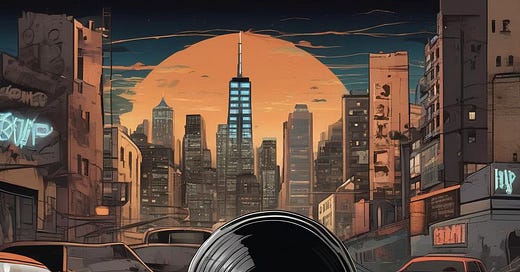Hip-Hop’s Frequency War: From Consciousness to Chaos
Beats Over Bars: How Hip-Hop’s Soundscape Went from Uplift to Upheaval.
Hip-Hop’s Frequency War: From Consciousness to Chaos
Hip-hop was never just music—it was a revolution. Born from the ashes of systemic oppression, economic neglect, and cultural erasure, it gave a microphone to the voiceless. Early pioneers like Grandmaster Flash, Public Enemy, and Tupac used the genre as a weapon of truth, exposing police brutality, racial injustice, and the struggles of inner-city life. Their lyrics were battle cries, their beats the heartbeat of resistance.
But somewhere along the way, the message got distorted. Today, mainstream hip-hop often glorifies violence, materialism, and self-destruction. The same art form that once empowered the marginalized now frequently reinforces the very cycles of trauma it once sought to dismantle. Why? Some blame corporate greed, others point to cultural shifts—but what if the manipulation runs deeper? What if the very frequencies embedded in modern hip-hop are designed to keep listeners agitated, distracted, and emotionally unbalanced?
The 440 Hz Conspiracy: A Weaponized Vibration?
In 1939, the American music industry standardized concert pitch at 440 Hz, replacing the older 432 Hz tuning found in classical and ancient music. Proponents of 432 Hz argue that it resonates with the natural vibrations of the universe, promoting harmony and healing. In contrast, 440 Hz has been linked to increased stress, aggression, and emotional dissonance.
• Nazi Germany allegedly pushed 440 Hz under Joseph Goebbels’ propaganda ministry to incite tension in crowds.
• The Rockefeller Foundation reportedly funded its adoption in America, fueling theories of a "war on consciousness.”
• Studies suggest 440 Hz elevates cortisol (stress hormone), while 432 Hz boosts serotonin (well-being).
When applied to hip-hop—a genre already rooted in raw emotion—the effects of 440 Hz may be amplified. Heavy basslines, aggressive lyrics, and dissonant melodies create a neurological feedback loop, reinforcing anger, anxiety, and even depression. The more listeners consume this frequency, the more their brainwaves sync to its chaotic energy.
The Industry’s Role: Profiting From Dysfunction
Record labels and streaming algorithms thrive on engagement—and nothing hooks the brain like conflict, shock, and adrenaline. The more extreme the content, the more clicks it generates. This has led to a sonic arms race in hip-hop, where artists are incentivized to push darker, more aggressive themes to stay relevant.
• Drill rap, with its nihilistic lyrics and haunting beats, often mirrors PTSD-like symptoms in listeners.
• Trap music’s repetitive, high-BPM rhythms can induce a trance-like state of numbness or agitation.
• Auto-Tune abuse—another form of frequency manipulation—distorts natural vocal tones, creating an eerie, disembodied effect.
The result? A generation subconsciously conditioned to normalize chaos.
The Counter-Movement: Hip-Hop’s Return to Consciousness
Despite the industry’s push toward dissonance, a growing wave of artists is rejecting the status quo. André 3000, once a mainstream rap icon, now crafts experimental flute music rooted in jazz and ambient frequencies. Others, like Kendrick Lamar, J. Cole, and Noname, infuse their work with spiritual depth, social critique, and higher vibrations
Underground collectives and lo-fi hip-hop producers are also embracing 432 Hz tuning, binaural beats, and meditative soundscapes, proving that hip-hop can still be both revolutionary and healing.
Reclaiming the Frequency: The Sonic Revolution Hip-Hop Needs
The battle for hip-hop's soul runs deeper than beats and rhymes—it's a war of vibrations. While mainstream music operates at the artificial 440 Hz standard (a frequency some researchers link to increased tension and disharmony), ancient tuning systems and modern sound healers point to 432 Hz as nature's resonance—a frequency that aligns with the human heartbeat, the Earth's electromagnetic field, and even the patterns of the cosmos.
This isn't just pseudoscience; it's a reclaiming of music's true power. History shows that sound has always been weaponized—from military sonic warfare to the psychological manipulation of mass media. But hip-hop, born from the struggle of oppressed voices, was meant to be a tool of awakening, not another instrument of control.
The Bigger Picture: Hip-Hop as a Tuning Fork for Humanity
Hip-hop didn’t rise from the Bronx just to entertain—it emerged to recalibrate a broken system. Its essence—the boom bap, the bass, the rhythm—was always meant to realign us with truth. But somewhere along the way, the industry turned it into a weapon of mass distraction, flooding the airwaves with frequencies of fear, aggression, and numbness.
The revolution won’t just be televised—it’ll be felt. It’ll vibrate in the chests of those who remember that music isn’t just art; it’s architecture for the soul. Every song is a blueprint for consciousness.
Final Call: The Frequency of the Future
Algorithms won’t save us. Record labels won’t liberate us. The change starts when we realize: Music is not just something we listen to—it’s something that listens to us. It shapes our nervous systems, rewires our thoughts, and either locks us into the matrix or frees us from it.
So ask yourself:
• Do you want music that numbs you or awakens you?
• Do you want frequencies that fracture your spirit or align it?
• Will you let the industry dictate your vibration, or will you reclaim it?
The choice is yours—the future vibrates with change. Now, turn the dial.





Omg this is so good Windy. Spot on. Weapon of mass distraction; brilliant. This is straight facts.
Excellent article Windy